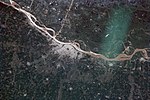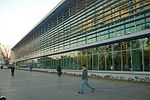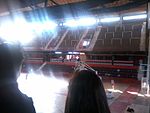Mariano Moreno bus station

Mariano Moreno bus station (Terminal de Ómnibus Mariano Moreno in Spanish) is a bus station located in the city of Rosario in Santa Fe Province, Argentina. The station receives near 340,000 buses a year (930 services per day) with an average of 13,500,000 people transported within a year (37,000 passengers per day), being the most important station not only of Rosario but other cities around. The station is located in the central-west region of the city, 3 km. from downtown Rosario. It has services such as bar, fast food restaurant, coffeehouses and other stores. Other services include parking lots, a bank and cash dispensers, a courier, a newsagent's shop, and accessible toilets. Buses daily depart to the main cities of Argentina and bordering countries.
Excerpt from the Wikipedia article Mariano Moreno bus station (License: CC BY-SA 3.0, Authors, Images).Mariano Moreno bus station
Cafferata, Rosario Luis Agote (Distrito Centro)
Geographical coordinates (GPS) Address Nearby Places Show on map
Geographical coordinates (GPS)
| Latitude | Longitude |
|---|---|
| N -32.9394 ° | E -60.6714 ° |
Address
Cafferata 702
S2002 Rosario, Luis Agote (Distrito Centro)
Santa Fe, Argentina
Open on Google Maps










